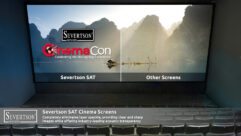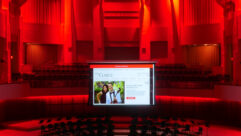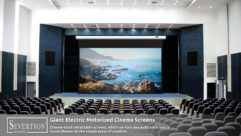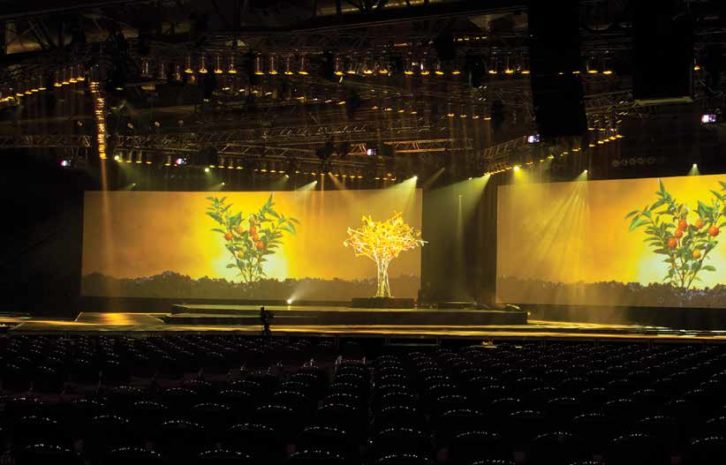
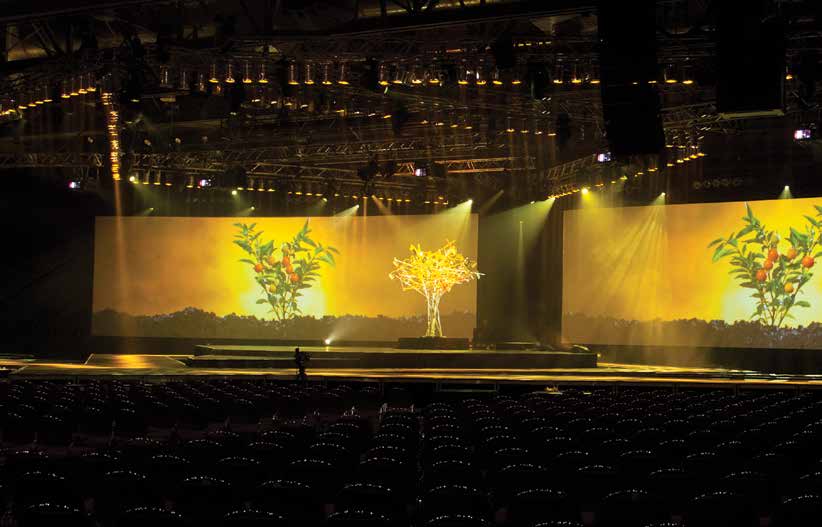
Anyone in the staging world knows how important projection screens are. Yet they are often relegated to the role of an inactive participant in the projector-screen-stage relationship. It is time to recognize this for what it is and demonstrate via some of the more recent developments in screen technologies that screens deserve equal status at the table of decision-making.
Before I begin our look at new developments and trends in screens, I want to give a shout out to the rental and staging companies who are in this writer’s opinion, the unsung heroes of the audio visual industry. If you think about it, the rental and staging industry falls under the Ginger Rogers scenario. She did everything Fred Astaire did in dance but she did it backwards and in high heels. Rental and staging companies do everything traditional AV integrators do but they do it in constantly changing venues, often in extreme conditions, and working under timelines and stress that would break lesser people. They must rely more completely on the tools of their trade and more often than not, these tools involve a projector and a screen. It is the variety of projectors and screens in combination with the venues, where challenges lie. By understanding the variety of tools and what they can do, the challenges become less onerous.
Turning our attention to screens, as we all know there are a significant number of companies that produce projections screens, but for our purposes we will focus on those that conduct significant business in the rental and staging market. These include both 800 pound gorillas in the niche, Da-Lite and Draper as well as smaller, but no less dedicated companies like Elite, AV Stumpfl, and most recently, Stewart Filmscreen putting their toe in the waters with a couple of new developments of interest. For this article, I had several great conversations with experts in the field including Jim Hoodlebrink, Rental and Screen Product Manager at Draper; Melissa Rone, Senior Product Marketing Manager at DaLite; and Franklin Moore of AV Stumpfl. Here is a short recap (and by no means an look at everything available to the stager.)

Jim and I talked about products and trends. He noted that “large applications continue to grow. We consistently get requests to push the sizes larger of our largest screens. StageScreen and Lace & Grommet products are at 120’ and 100’ wide and larger if needed. Height is also being pushed past 30’ high. Large application needs are not new but the quantity of them appears to be growing.”
Worthy of note, is the development of products specifically for the rental and staging industry. One example is the Draper StageScreen, a relatively new concept in projection screen design. It is designed specifically to be flown, but can also be used with legs. According to Draper, “it is the strongest and most rigid screen on the market.” Under the umbrellas of tools at your disposal, the truss system is completely modular. All available sizes are built from combinations of the same 6 standard color-coded frame sections. Not only does this make screen assembly faster and easier, but if a frame section should ever become damaged you can replace it in seconds without tools. Well thought out products like this take the concept of inventory management to a new level.
Jim went on to say that “along with large venue needs, is the trend toward curved screens. Edge blending on the large or curved screens is typical.” He noted that “the larger curved screens also lead to better understanding of the materials used to optimize the image. This has led to a willingness to spend a little more money on a dedicated surface that is specific to the application. For example, a gray material that helps with contrast on a curved screen or a low gain gray or white dedicated to controlling hot spots and blend zones.” He also pointed out that borderless screens were one of the newest trends. “It has been out there for some time for the installation market but it is a new look for rental and staging customers, and appears to be catching on. Our Edgeless Clarion and Profile series with a very thin bezel, are our borderless products, and are doing well.” In conversation with experts like Jim, it is possible to see where the industry is headed and we can prepare accordingly.
Turning our attention to another manufacturer, Da-Lite, we go from trends to a new product. Their excitement was all about their new Fast-Fold NXT screen. I can hear it now, what can possibly be new in this decades old iconic line known as Fast-Fold? Stay tuned, there is actually a good story to tell that we can learn from in taking a well-known product and totally (yes totally) redesigning it to fit the changing needs of their customers. Melissa Rone of DaLite was happy to share her excitement and it was contagious. She said it all began over three years ago with research they conducted. This was not a simple form requesting random ideas for improvements sent to a few R&S companies, but a true primary research project that spanned not only time but countries and it focused on the business people and the technicians at rental and staging companies and also the end users as well. The feedback they received was enlightening to say the least.

According to Melissa, the respondents said they did not like the “speedy cranks” and the famous screen snaps were a pain, literally. I can echo those complaints. The pull tabs were not convenient nor easy to use. People did not like the rivets that held the 1” square tubes together and many found the hinge points were weak. Finally, the research noted that bowing was a problem that needed to be eliminated. In short, they asked a lot of good questions and took the time to collect the data and really listen to the answers. Now this in itself is not totally unique, but the time spent and intense focus is what made this stand out. Now we come to the “proof of the pudding” part. Did they in fact do anything significant with the data gathered or was it all done as a cosmetic appearance of listening?
Check this out from the top down. They came up with a totally new and more robust aluminum extrusion for the frame ending decades of using the old 1” square aluminum. There are no more tabs to hurt your fingers. They use fixed corners that snap together with the surfaces aligning to the corners. They eliminated the external hinges and now they are built into the extrusion caps. No more rivets. No more cranks, now giving way to push buttons. You can set the NXT in landscape or portrait modes and they can be placed on newly designed T legs or flown. They even include micro height adjustment. They listened to their customers and redesigned the road cases into two models with the fabric fitting in the top of the cases and never touching the frame. No need for tools, bolts, or fasters. They made it all “easier, faster, and better.” While the final product is certainly worthy of praise, it is the process of in-depth research and taking the data and then engineering a new version of an old standard that will in itself stand the test of time.
We are seeing a significant amount of movement toward direct view LED in the R&S community. As most of us know, the smaller dot pitches, the more expensive the panels. The engineering team at Stewart Filmscreen have developed a product known as Fideledy Vison. It is a diffusion material that for example, makes a 4mm dot pitch wall look like a 2mm. It has the added benefit that it eliminates moiré when filmed with a digital camera. The second development worthy of note is in the area of ambient light rejection or ALR screens. Up to this point, these screens have been rigid or semi rigid in nature. Stewart Filmscreen has just introduced their new Phantom HALR screen that is both high resolution (capable of over 16K resolution!) but is a flexible material. I would not be surprised to see this in R&S applications so stay tuned.

Austria’s AV Stumpfl has redesigned the internal drive mechanism of their 125 roll-up screens. The new design were applied to all Inline 125 products as of October 2016. Tobias Stumpfl, CEO of AV Stumpfl, said: “We’ve combined feedback from customers with the world’s best materials with over 40 years of engineering excellence to create a new mechanism design– with sleeker dimensions, reduced weight but even higher stability – the result of which will be less risk of transport damage and simpler installation for our customers.”
The new design of the Inline 125 will continue to feature the sleek invisibility of the previous design, but it will be about 30mm shorter in overall length, while the surface dimensions will remain unchanged. This has been achieved with a new, modular concept for the internal mountings, bearings and drives in combination with a new shaft design that has been made of hardened aluminum alloy for higher stability and precision of the whole product. In addition to a new look, the new Inline 125 roll-up screens also come with new control options; cable, wireless and DMX.
Franklin Moore, President at AV Stumpfl’s US distributor said: “As well as Fullwhite and Fullwhite Curve screens for fixed installations, we have Monoblox, Varioclip and Vario products which are the industry standard for portable projection screens. We see an increasing need for these type of screens that are able to work in complex staging applications in conjunction with lighting and projection technologies, live performers, special staging effects and even moving projection surfaces and scenery.”
There you have it, a snapshot view of new trends and developments. What many assume to be a mature industry, is showing some signs of interesting developments and new products. We are seeing trends in sizes and shapes of screens. There are exciting new products that radically improve on some of the time tested staples in the industry and there are new screen materials that we can use as tools to overcome some of the venue issues that we all face such as ambient light rejection. My recommendation is to reach out to the screen companies and see what they have to offer that is new and exciting. You may be surprised and you will be glad you did.

Alan C. Brawn, CTS, DSCE, DSDE, DSNE, DCME, ISF, ISF-C, (alan@brawnconsulting. com) is a principal of Brawn Consulting, an audio visual consulting, training, educational development, and market intelligence company with national exposure to major manufacturers and integrators in the industry. He was formerly President of Telanetix and previously National Business Development Manager and National Product Marketing Manager, Pro AV Group, Samsung Electronics. He is a recognized author for leading AV industry magazines such as Systems Contractor News, AV Technology, Digital Signage Magazine, and Rental & Staging. Alan has been an Imaging Science Foundation fellow and instructor since 1994, and co-founder of ISF Commercial. He holds CTS certification, is a senior faculty member of InfoComm and the moderator of the ANSI Projected Image System Contrast Ratio (PISCR) standard. Brawn was awarded the InfoComm Volunteer of the Year Award in 2011 and he is the past Chairman of the Digital Signage Federation and the Pro AV Hall of Fame recognition from rAVe in 2004. Alan Brawn received the Fred Dixon Lifetime Achievement in AV Education from InfoComm in 2015.



